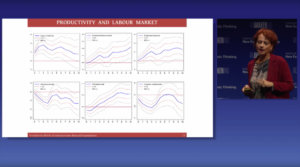The prevailing wisdom that aggregate demand ‘shocks’ determine short-run cyclical fluctuations around a supply-determined equilibrium growth rate and an associated equilibrium unemployment rate (or NAIRU) has been called into question by various streams of literature in the last decades. Specifically, a recently revived literature on hysteresis finds significant persistence in the effects of recessions and negative aggregate demand shocks (Blanchard et al. 2015; Martin et al. 2015).
This paper aims to assess such tendency to return to a supply-determined potential output, independent of
aggregate demand, after episodes of demand expansion. In line with the ‘hysteresis’ literature, we assess the
persistence of aggregate demand effects on key macroeconomic outcomes. However, in contrast with much
of that literature, we assess whether ‘persistence’ is detected also in instances of demand expansion.
We study 94 episodes of demand expansion in 34 OECD countries between 1960 and 2015. We look at the sum of primary public expenditure and exports, a variable we call ‘autonomous demand’. We define an expansion as a large yearly percentage increase in autonomous demand, ‘large’ meaning more than a standard deviation above the country mean. W e analyse the impact of these expansions on key macroeconomic outcomes in the subsequent decade, using various techniques to deal with endogeneity. We employ two main approaches: a dynamic two-way fixed-effects model, analogous to a standard difference- in-differences estimation, and a propensity score-based specification which explicitly models selection bias. We find a highly significant persistent effect on the GDP level: a one-off expansion in our autonomous demand variable by (an average of) 5% is associated 10 years later to a GDP level higher by around 3%, with no sign of mean-reversion. We also document strong persistent effects on capital stock, employment and participation rates. Effects on productivity and unemployment rate are also strong and quite persistent, but evidence regarding their permanency is more mixed. We do not find that expansions, on average, cause high or accelerating inflation.
Our results lead us to ask whether hysteresis should be considered a ‘distortion’ in the working of market economies that holds only in specific circumstances – as the mainstream literature has generally suggested – or whether it is, in fact, a pervasive phenomenon which holds most of the time.





